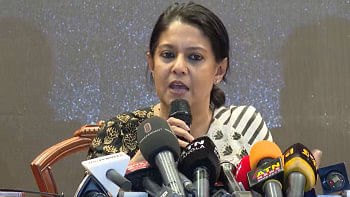Growers now buyers

Queues get longer under the scorching sun at midday at the backswamp of Sunamganj for subsidised rice and wheat flour.
People start lining up at 10:00am at points of open market sale (OMS) across the district to buy rice and flour at Tk 15 and 17 a kg, a lot cheaper than the market prices.
The local administration expanded the OMS facility on April 9 after early flashfloods damaged Boro crops on most parts of the district.
Those who belong to a predominantly farming and fishing community of the northeastern wetland, life upended by the late March's flashfloods is not going to be same again anytime soon.
With most of their standing mono crops gone under water for excessive rains and onrush of floodwater from hills, they are now hard-crunched with little cash in hand to buy food and meet other immediate needs.
Of 1.6 lakh hectares of farmland under Boro cultivation this season, 1.13 lakh hectares have been submerged while crops grown on nearly one lakh hectare completely destroyed.
This made Sunamganj the worst-hit among flashflood-affected haor regions, including Sylhet, Habiganj, Netrakona, Kishoreganj, Brahmanbaria and Moulvibazar.
The government has estimated loss of nearly half a million metric tonnes of Boro rice cultivated in the wetlands of these northeastern districts, but at the same time said the loss would not have much impact on the projected national Boro output of 19 million tonnes.
Meanwhile, people in distress, who took credits to invest in yearly Boro cultivation, demand that they be exempted from loan repayment, the region be declared “disaster prone area” and steps be taken to stop recurrence of floods through building protection embankments.

An executive engineer of Water Development Board in Sunamganj was withdrawn four days back amid allegations of corruption in the construction and repairing works of the embankment surrounding the haor areas.
According to the Sunamganj district administration, 300 tonnes of rice has been arranged for relief distribution among flood victims.
However, it is not clear as to how much of that has been distributed as queues for OMS rice and flour are getting longer by days. This is happening when consumers in Sunamganj are rushing to hoard rice fearing imminent shortage due to the damage of crops, and as a result rice price has gone up in the local market.
Talking on phone, district Food Controller Abdur Rouf said that prior to the flashfloods in late March, nine OMS points were in operation in Sunamganj district headquarters.
"We now expanded the OMS operation to all 11 upazilas of the district.”
As many as 42 centres are now selling one tonne of rice and one tonne of wheat flour every day, Abdur Rouf said.
He acknowledged the increase in rice prices in Sunamganj after floods, but expressed the hope that with the expansion of OMS operation and relief being distributed by the district administration things would come under control.
Meanwhile, due to the accumulation of what was left of the damaged Boro crops in stagnant waters in certain haor areas, fish population are dwindling fast.
Farmers and fishermen have complained of fish dying at places.
Talking to The Daily Star yesterday, Agriculture Minister Matia Chowdhury said the government had already decided to waive interests on credits taken for farming in the affected areas.
"Besides, we're also planning strategies to help affected farmers of the haor region."
Experts said flashfloods usually wreak havoc on haors in April but this time crops went under water on March 27. They blamed the new phenomenon on climate change.
Losing the only crop of the year, many farmers in Sunamganj, Kishoreganj, Netrakona, Habiganj and in some other northeastern districts sold their cattle and other valuables while many others left their homes for nearby towns to find manual work.
Director General of the Department of Agriculture Extension Manzurul Hannan earlier said farmers cultivated Boro rice on 4.5 lakh hectares of haor land this year and an estimated 1.41 lakh hectares went under water.
However, the data collected by our correspondents from the district agricultural offices shows that around 2.5 lakh hectares were submerged with crops getting damaged partially or fully.
Boro makes up 55 percent of the annual rice output and it is cultivated on 48 lakh hectares of land. Last year, the country saw production of 1 crore and 89 lakh tonnes of Boro rice.
Our Sylhet and Moulvibazar correspondents contributed to this report.


 For all latest news, follow The Daily Star's Google News channel.
For all latest news, follow The Daily Star's Google News channel. 



Comments